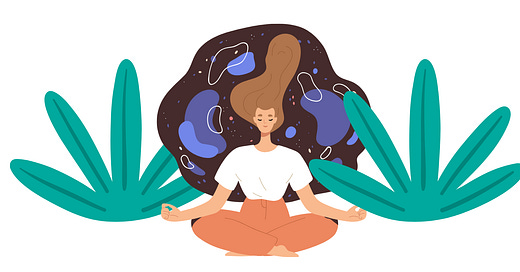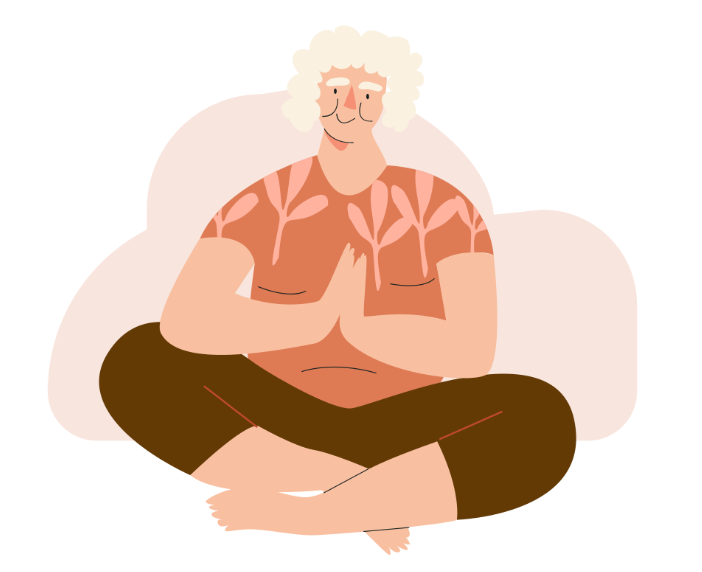Stop Trying to 'Do' Mindfulness! Your 2025 Breakthrough Guide
The One 15-Minute Daily Habit That's Reverse-Engineering Ageing in 2025
I get it! I’ve been there.
When I started my mindfulness practice, I was a member of the 'I Can't Meditate' Club, as so many are. It was a time in my life where I desperately needed to find peace. Instinct told me to persist. It wasn’t too long (much less time than I expected) before things started falling into place.
Finally, I began to stop 'doing' mindfulness, and started practicing ‘being’ mindful, instead. The persistence, and all it brought me, was more than worth it.
And that was before I knew just how extraordinary this practice could be for so many aspects of joyful, thriving ageing.
In fact, when we kicked off 2025: The Year of Joy in Issue 02 of Road Trip to Younger magazine, there was no doubt in my mind where to start. A guide to mindfulness would give us the opportunity for an entire year of healthy transformation.
"I just can't do it!"
That was the constant refrain of friends, family members and strangers over the months of researching the benefits of mindfulness for healthy thriving ageing. I can't tell you how many times I heard it. So many people spoke about the struggle they have with their ever-chattering mind.
A wall was up and I knew I needed to help pull it down. Because there truly is nothing like mindfulness—if there was a drug that offered all the potential benefits of a consistent mindfulness practice, we'd all be lining up for it.
Sure, you'd expect a regular mindfulness practice would support things like sleep and stress. But its benefits stretch far wider.
While the science is still unfolding, it's becoming clear that a consistent mindfulness practice of, say, 15 minutes a day, has the power to impact all manner of ageing metrics.
Mindfulness, by the way, is a form of meditation, which is why it is often referred to as mindfulness meditation. It's also been the subject of countless studies that have highlighted its many benefits.
In particular, the research points to positive benefits for your weight, brain, hormone balance, heart health and your risk of diabetes. There's even strong evidence that it can expand your grey matter and alter your gene expression - the latter particularly in the area of inflammation (or inflammaging, as many experts refer to it, on account of the acceleration of ageing it can set in motion).
See Road Trip to Younger magazine’s Issue 02 here, and you'll see why 15-Minute Mindfulness is a true '5-star Destination' with its own comprehensive 'Travel Guide', including 'Key Attractions' and 'Road Maps'. (Think Lonely Planet meets the science of healthy longevity.)
But, full disclosure, I stuffed up…
Yes. Given how many people had told me how much they struggled with the very idea of a mindfulness practice, I dropped the ball.
Almost as soon as I sent the magazine out, I realised my error: the original post, while helpful throughout, just didn't properly explain the practice itself. It didn’t help women really get on the road to mindfulness. I hadn’t held their hand as my service journalist's heart knew I needed to.
So the following dedicated guide comes with my apology and lesson learnt! Th key how-to components here are also now inserted into Issue 02 of the magazine.
Let’s start with the elephant in the middle of the road:
Meditation may be simple, but it’s not always easy.
Even my yin yoga teacher, Joseph, who studied mindfulness meditation at a Buddhist monastery for many years, admits even for the most experienced practitioner, surrendering to mindfulness, and being in the moment, does not always come easy.
What tends to make it easier - the game-changer, if you will - is something that takes time to grow. You might be surprised to hear that 'something' is self compassion.
Strengthening self compassion takes time. And that discomfort, of putting self compassion under pressure is in many ways the secret. Quietening the chatter and leading ourselves back to the present moment ends up being akin to resistance training. The art of mindfulness is developed by gently, over time, growing your strength in resisting feelings of failure, and thoughts of not being 'cut out for this'.
And it's well worth pushing through this period of discomfort. Once you get into the rhythm of a mindfulness practice, you’ll start to see it in a new light: a luxurious treat for your mind and body, with all those age-defying benefits as an added bonus.
We'll come back to ways to build our self compassion. But first, let's get the basics in place.
Setting up your mindfulness practice
Make yourself comfortable. Experiment with sitting, standing and lying down. Add cushions, bolsters, blankets and any other props that make it feel good for you. Creating the right environment helps establish a sustainable practice.
Find a quiet place. It may be indoors or outdoors—ideally where you won't be interrupted. This helps minimise external distractions and allows you to focus inwardly more easily.
Consistency is key. Try to practice at the same time every day, whether it's in the morning, during your lunch break, or before bed. The more consistent you are, the more natural it will feel and the easier it becomes to maintain.
Create a ritual. Pair your mindfulness practice with sipping your favourite tea, or lighting a candle. These small touches can enhance the experience and make it even more enjoyable, helping to anchor it as part of your daily routine.
Your mindfulness practice starts here
There’s no single ‘right way’ to practice mindfulness. Over time, you’ll find what works best for you.
Here’s a place to start
🧘🏽♀️ Take a few deep breaths. Enjoy them. Send your inner-overachiever on a holiday. Put any sense of "I MUST be mindful!" away.
🧘🏽♀️ As you breathe, quietly point your thoughts and senses towards the absolute present—to the 'nowness of the now'. This immersive focus on the present moment is what defines mindfulness meditation.
🧘🏽♀️ Gently focus on the sound and feeling of the cool breath coming into your nose, and sense your abdomen rising as you breathe in.
🧘🏽♀️ Be aware of your abdomen naturally falling as the warm air moves out through your mouth.
🧘🏽♀️ Continue to listen to your natural calm breath. Being fully focused on your breath is one of the surest ways to be in the present moment.
🧘🏽♀️ Feel yourself seamlessly stringing together 'now' moments into a beautiful stream, moment upon moment.
🧘🏽♀️ Sense the freedom of being within this stream of 'now' moments, uninhibited by thoughts of the past or the future.
🧘🏽♀️ You may become aware of other sounds. As they enter your consciousness, experience them for what they are as a sound, as if you've never heard that sound previously. Try not to give the sound a label.
🧘🏽♀️ Thoughts will inevitably bubble up. They may be mundane, or they may have an emotion of some kind attached to them. You may find yourself judging yourself. This momentary feeling is normal and natural. Become quietly aware of this thinking.
🧘🏽♀️ Take a full calm breath of slow self compassion—after all, as many seasoned practitioners say, this is a good sign: noticing a thought in 'the now' is proof of being in the now!
🧘🏽♀️ Quietly, and even lovingly, acknowledge your wandering mind and guide it back to the current moment, softly refocusing on your breathing.
How do I let go of my thoughts?
The biggest challenge many people face in their mindfulness practice is remaining in the present moment and particularly in having techniques to manage thoughts that arise. The secret of many long-time mindfulness meditators is visualisation. By having some reliable mental images ready to help you gently release those thoughts it’s often much easier to return to the present moment.
Here's some imagery worth trying when your mind drifts from 'the now':
Picture your thoughts as bubbles in gently boiling water, rising to the surface and softly disappearing.
Imagine your thoughts as clouds drifting across the clear sky of your mind, neither pushed away nor held onto.
Visualise each thought as a leaf that you place on a slow-moving river, watching it float downstream and out of sight.
Road-trippers might see thoughts as scenery passing by, gradually fading into the distance in the rear-view mirror.
Whichever approach you choose, be patient with yourself. Some days will be easier than others, and that’s perfectly okay!
Important: If mindfulness meditation brings up difficult or distressing feelings, pause your practice and seek professional medical advice. Your personal wellbeing comes first.
A final thought: remember when I mentioned being part of that 'I Can't Meditate' Club?
Well, the most rewarding part of my mindfulness journey has been watching other former 'I Can't Meditate' Club members also discover that not only can they meditate, but they're actually really good at it, and many wouldn’t be without it.
And here's something exciting we discovered in Issue 02 of Road Trip to Younger magazine: while mindfulness alone earns its 5-star rating for healthy ageing, there's a way to upgrade it to a 6-star destination.
Just add social connection. Whether it's joining a meditation group, sharing your practice with a friend, or simply discussing your mindfulness journey with others, this combination creates an even more powerful catalyst for joyful, thriving ageing.
I hope this makes you excited and inspired to hit the road!
Please feel free to share your experiences, tips, challenges and thoughts in the comments below so we can navigate our way to that joyful scenic road to mindfulness, together.















This is awesome! Thank you Brodee 😊
As a mindfulness teacher one of the biggest barriers is getting over the “I’m not doing it right” thing people stress over. I don’t know who started the “empty your mind” thing but it’s done mindfulness a disservice